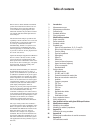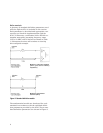
2
3
3
3
4
5
5
7
7
8
9
9
9
11
12
12
12
14
14
15
16
16
17
17
17
18
18
18
18
19
19
19
19
19
20
20
20
21
21
22
22
22
23
23
26
29
Introduction
Measurement errors
Measurement calibration
Calibration kit
Standard definition
Class assignment
Modification procedure
Select standards
Define standards
Standard number
Standard type
Open circuit capacitance: C
0
, C
1
, C
2
and C
3
Short circuit inductance: L
0
, L
1
, L
2
and L
3
Fixed or sliding
Terminal impedance
Offset delay
Offset Z
0
Offset loss
Lower/minimum frequency
Upper/maximum frequency
Coax or waveguide
Standard labels
Assign classes
Standard classes
S
11
A,B,C and S
22
A,B,C
Forward transmission match/thru
Reverse transmission match/thru
Isolation
Frequency response
TRL Thru
TRL Reflect
TRL Line
Adapter
Standard class labels
TRL options
Calibration kit label
Enter standards/classes
Verify performance
User modified cal kits and Agilent 8510 specifications
Modification examples
Modeling a thru adapter
Modeling an arbitrary impedance
Appendix A
Calibration kit entry procedure
Appendix B
Dimensional considerations in coaxial connectors
Appendix C
Cal coefficients model
Table of contents
Known devices called calibration standards
provide the measurement reference for net-
work analyzer error-correction. This note
covers methods for specifying these stan-
dards and describes the procedures for their
use with the Agilent Technologies 8510 net-
work analyzer.
The 8510 network analyzer system has the
capability to make real-time error-corrected
measurements of components and devices
in a variety of transmission media.
Fundamentally, all that is required is a set
of known devices (standards) that can be
defined physically or electrically and used
to provide a reference for the physical inter-
face of the test devices.
Agilent Technologies supplies full calibration
kits in 1.0-mm, 1.85-mm, 2.4-mm, 3.5-mm,
7-mm, and Type-N coaxial interfaces. The
8510 system can be calibrated in other inter-
faces such as other coaxial types, waveguide
and microstrip, given good quality stan-
dards that can be defined.
The 8510’s built-in flexibility for calibration
kit definition allows the user to derive a
precise set of definitions for a particular set
of calibration standards from precise physi-
cal measurements. For example, the charac-
teristic impedance of a matched impedance
airline can be defined from its actual physi-
cal dimensions (diameter of outer and inner
conductors) and electrical characteristics
(skin depth). Although the airline is
designed to provide perfect signal transmis-
sion at the connection interface, the dimen-
sions of individual airlines will vary
somewhat—resulting in some reflection due
to the change in impedance between the test
port and the airline. By defining the actual
impedance of the airline, the resultant
reflection is characterized and can be
removed through measurement calibration.
The scope of this product note includes a
general description of the capabilities of the
8510 to accept new cal kit descriptions via
the MODIFY CAL KIT function found in the
8510 CAL menu. It does not, however,
describe how to design a set of physical
standards. The selection and fabrication of
appropriate calibration standards is as var-
ied as the transmission media of the partic-
ular application and is beyond the scope of
this note.


















